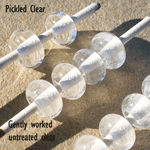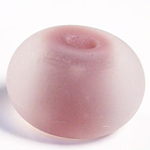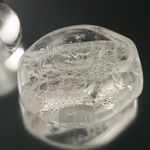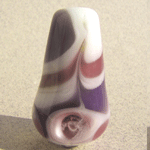CiM Tester Feedback
We are committed to making an optically clear Clear [no green or blue tints]. During the inspection process, we are careful to remove rods that are not a consistent 4-7 mm diameter, to check that the rods are straight and smooth without bumps, and to remove any rods with seeds, bubbles, stones, or other impurities. We limit handling to prevent scratches, and we package the rods by individually wrapping in tissue paper to prevent scratching during shipment.
Like all Messy Colors, our Clear has been formulated and tested to be 104 compatible. We strive to be as consistent as possible from batch to batch, and to reproduce the Clear on a timely basis so that it is available when you need it.
Our testers are sharply divided about whether or not they like Messy Clear. About half reported that they loved Messy Clear and experienced no problems. The other half reported that they could not cope with what they described as boiling.
Thanks to our testers, we’ve been able to establish that the wide range of responses is due to the wide range of working atmospheres.
Artists who preferred Messy Clear describe their working style as “cool,” or are quite often using a Hot Head. Several testers who could be described as working “hot” noted that they were successful in using Messy Clear without boiling it if they worked it very slowly [much slower than they preferred to work] in the outer reaches of the flame.
If you find yourself to be one of the users who can’t seem to prevent Messy Clear from boiling, then I would recommend either working cooler or using a clear that can tolerate working hotter.
There is also a relevant point about the ends of our rods. As part of the quality control process, the rods are divided into bundles which are stood vertically and ground over a disc to smooth the ends. Our purpose is to remove any sharp and potentially dangerous edges. Several testers noted that the ground ends of the rods have a tendency to scum. So we discontinued the grinding process for Messy Clear [though we continue to do it on all other color rods].
Thank you to our illustrious testers who have given us this comprehensive feedback.
-
We asked our testers to compare Messy Clear to other 104 clears. [Please note that the variety of responses below were in regards to the same batch of Clear.]
“I had just discovered this clear after I got fed up with the Italian clears. So, having had some time to work with CiM's, I prefer it the most because of its clarity and affordability. I have never found it to bubble or boil. It also doesn't scum after working for a long time [I tend to work beads for at least 45 minutes or more].” – Renee Wiggins
“The clear is awesome, especially the stringers for encasing – doesn’t boil, few bubbles, great to melt. The Moretti super clear is good as well, but I love the smaller size of Messy Clear.” – Donna Dorman
“Messy Clear is my favorite clear, except when annealing at temps below 950 degrees, as it generally cracks at those temps, or when used with silver-laden glass.” – Kathy Coon
“I sometimes use Messy Clear, but not when I use silver glass.” – Pat O'Brien
“I ONLY use Messy Clear and find that it is almost always compatible with the silver reactive glass that I almost exclusively use at the moment. This most recent batch of test glass, though, was more bubbly and scummy than usual.” – Sue Stewart
“I use Messy Clear as we can’t get Lauscha in the UK, and Effetre and Vetrofond don’t cut it for me. I have found recent batches of Messy Clear not to be as good as previous, it has a tendency to boil and seed and needs to be worked very very cool.” – Claire Morris
“I only use Messy Clear for encased spacers due to the over soft quality of clear. One must carefully watch how much heat builds up in the glass at all times. Flame cutting even up very high often will boil the glass despite being conscious of working cool.” – Starleen Colon
“I don’t encase much, but when I do I prefer CiM clear, less issues all around.” – Elasia
“This is the best clear I've ever used.” – Terri Budrow-Nelson
-
Some testers reported Clear "boiling," "scumming," or "frothing."
“I find that you need to warm CiM colors more carefully to avoid the cracking, boiling. Even though I have observed bubbling and frothing, I find it’s from working the glass too hot. When I move it out a little further, the issue resolves. CiM seems to need to work just a smidgen ‘cooler’.” – Jennifer Borek
“Clear is a dream for me. I have not found it to boil at all.” – Renee Wiggins
“Messy Clear is a boiling problem, even when worked cool on any other torch greater than a Hot Head.” – Starleen Colon
“I have bought Messy Clear about 2 or 3 times and one batch scummed a lot. I sold it to the students, because we use Hotheads on courses and it did not scum that much with a cooler flame.” – Maija-Leena Autio
“My experience with CiM clear is that it likes to be treated on the gentle side, not using lots of heat.” – Leslie Anne Bitgood
“Clear works beautifully for me as long as I clean the tip of the rod, 'cook' it for a while to burn off what little bit of micro-bubbles remain, and then keep working it without letting the rod cool off. Once it cools, I have to peel the tip again and start all over again.” – Elizabeth Long
“I had great luck with Messy Clear; I use the clear all the time. I work in a cooler flame.” – Donna Dorman
"As for the clear- granted, it's not as crystal clear as Diamond Clear, but it's also not as persnickity or nearly as expensive. I can usually burn off any little bubbles or scum that forms. So CiM clear gets my vote." – Kandice Seeber
-
Special thanks to Terri Budrow-Nelson for providing the photo in this section.
“Wow! Look at the difference huh?! Pickling makes a HUGE difference in clarity for sure! You will still need to wipe down your rods with a CLEAN cloth and either window cleaner or alcohol before using because even though the rods have the grime cleaned off of them the oils on your skin will still make the glass scuzzy if you don't use clean rods.” Read more at Genea’s blog. |

|

| "Messy Clear seems to etch into a lovely frost."
–
Genea Crivello
|
"Two things did impress me. One is the packaging - it is wrapped in tissue so that none of the rods touch each other. This is a full wrap and roll, so that the glass is not rubbing and scratching in transit and storage. Second thing that impressed me was that I actually managed to encase silver foil and keep it looking silver, without it developing a gold cast." Read more at DragonJools blog. |

|

| “I avoid the Messy Clear when spot encasing because it has a tendency to boil and scum at the tip when heating. If I can pull off the boiled tip, the rest of the melt seems better as long as the new tip stays molten and I do not cool and re-heat the tip. As you can see in the picture on the left, the first dot of clear that I put on the bead has the most boiling and scum. As I added more dots, the scumming got better on the second bead to the right.”
–
Bonnie Polinski
|